Breathing Room: HVAC Solutions and Resources for COVID Risk Mitigation
HVAC systems may be an important tool for reducing COVID risk in library buildings; the details make all the difference.
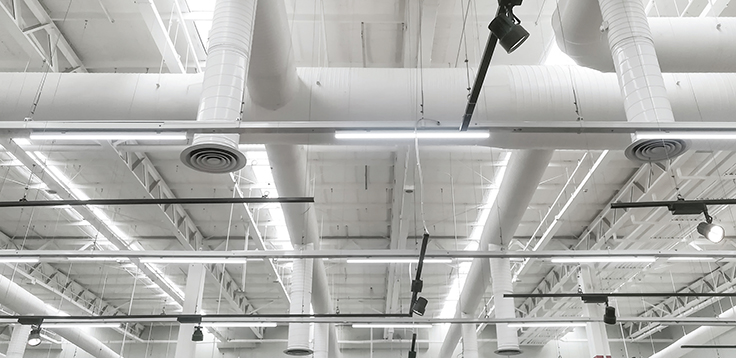
As cold weather shuts down outdoor services across much of North America, many libraries are assessing how to provide materials and programs indoors in a way that is safe for patrons and staff. While the REALM project studies fomite, or surface, transmission in libraries, less is known about airborne transmission. Precautions for larger droplets, such as masking and distancing, have been shown to mitigate transmission, but growing evidence about the interplay between air velocity and smaller aerosols shows that airborne spread may be more complex than initially believed. How do we make our indoor environments safer?
Heating, ventilating, and air-conditioning (HVAC) systems are now center stage. However, in these systems, the “priority is still far too often too much on temperature and not indoor air quality,” says Ian Booth, a partner with design firm BuroHappold. “Finally things will start to get taken seriously in terms of levels of fresh air, control of fresh air, indoor air quality, and energy efficiency.”
We interviewed engineers, library facilities managers, and library directors. Though their strategies and opinions about specifics sometimes differ, a number of common themes and best practices emerged.
CONCERN IS IN THE AIR
Mark Weir, an environmental engineer and researcher at Ohio State University’s College of Public Health and director of the Ecology Epidemiology and Population Health Program at the Infectious Disease Institute, is running a research project on the effects of HVAC systems and technologies on the spread of SARS-CoV-2. “In the room, we have a pretty good ability to say what other people’s risks will be. Perfect? No, not by a long shot. There’s a lot of other pieces that go to that—how the air flows in the room, how people are moving around.” Even though aerosol transmission of COVID-19 has not yet been proven through multiple peer-reviewed studies, it cannot be discounted.
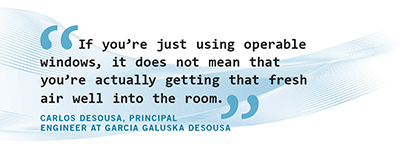 While a number of factors affect indoor air quality, the main method of controlling it is through the HVAC system. The ways that mechanical systems regulate the variables in the indoor air are known as “engineering controls.” They include ventilation, air distribution, filtration, disinfection, and temperature and humidity control. The approach to combating contaminants with HVAC consists of two basic strategies: increase ventilation and remove particles through increased filtration or disinfection.
While a number of factors affect indoor air quality, the main method of controlling it is through the HVAC system. The ways that mechanical systems regulate the variables in the indoor air are known as “engineering controls.” They include ventilation, air distribution, filtration, disinfection, and temperature and humidity control. The approach to combating contaminants with HVAC consists of two basic strategies: increase ventilation and remove particles through increased filtration or disinfection.
VENTILATION AND AIR CIRCULATION
Supplying the indoor environment with fresh air through ventilation is key to promoting healthier air quality. In the webinar “Heating, Ventilation, and Air Conditioning Strategies for COVID-19” from the Federal Facilities Council (FFC) on October 28, William Bahnfleth, engineer and chair of the American Society of Heating, Refrigerating and Air-Conditioning Engineers’ (ASHRAE) epidemic task force, stated, “Ventilation needs to be clarified to mean ventilation with outdoor air. We dilute contaminants indoors by bringing in outdoor air that’s virus-free.”
Mechanical ventilation offers the most control over indoor air quality. The rate at which stale air in a room is replaced by fresh or recirculated air is known as the air exchange rate. In general, the higher the rate, the more air dilution and the less potential for virus transmission. But it’s important to keep practicality and occupant comfort in mind, too. According to Weir, “In a large open area, you’re really only going to be able to achieve two, maybe three [exchanges per hour]. If you were able to achieve six, it would be like tornadoes going around.”
“Dedicated Outside Air Systems (DOAS), or systems with an economizer that can operate at 100 percent outside air to increase ventilation, should be operated so that you have the most amount of ventilation possible,” says Carlos DeSousa, principal engineer at Garcia Galuska DeSousa. “If it can still maintain the temperature in the space, that would be ideal.” However, HVAC systems designed for limited percentages of outside air intake would be compromised at this setting. Bahnfleth states, “If a system that was designed to recirculate a large amount of indoor air through filters is put into 100 percent outdoor air mode, the effectiveness of the filters drops to zero. Health-care ventilation standards require fairly high quantities of outdoor air, but also very high rates of recirculation through efficient filters. ASHRAE considers increased filter efficiency to be a better way to increase particulate removal than increasing ventilation rate.”
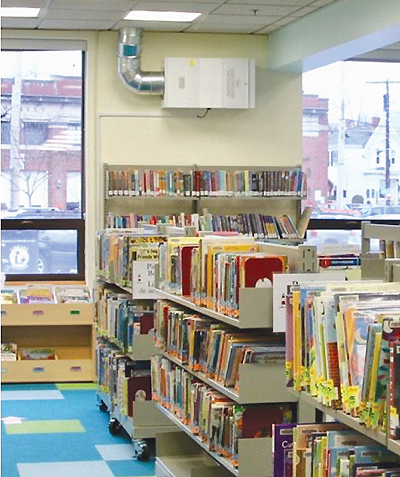 |
UP AND AWAY Wall-mounted HEPA filters at the Sawyer Free Library, Gloucester, MA, keep units in the youth services area out of reach of inquisitive children. Photo courtesy of Sawyer Free Library |
WINDOWS AND FANS
If your system can’t provide adequate air changes, outside air ventilation can be accomplished through operable windows. Libraries using operable windows as the main means of ventilation must ensure that the air brought in is exhausted at the other end of the room and filtered and/or purified while within the space. “If you’re just using operable windows, it does not mean that you’re actually getting that fresh air well into the room,” says DeSousa. A box fan connected to the window can help, though his colleague, principal engineer Dominick Puniello, clarifies, “We would not recommend just using a box fan, but use it as a supplemental means with a true certified HEPA [high-efficiency particulate air] room filter.” Some library directors have inquired about the use of ceiling fans, but according to DeSousa, “the ceiling fan would just recirculate the air. So it’s not the same benefit.”
However, a ceiling fan may be better than nothing. Weir cites a prison in Ohio with high windows that sought to create air movement with fans. “As long as you have unidirectional flow, and you know how much you’re moving, you’re in better shape than leaving everything as it is.”
This is exactly the advice that Jenny Benedict, director of the Sawyer Free Library in Gloucester, MA, received from an environmental assessment for one portion of her multigenerational building, which has operable windows on all four sides and a 30–40 foot ceiling height. “We have ceiling fans and they seem to think that those were fine because they would increase the circulation of the air in the space. The recommendation was to be sure that pedestal fans and window air conditioner units don’t blow over people to other people. You wouldn’t want to be blowing particles from someone who is infected with the virus onto other people.” To prevent ceiling fans from creating the same problem, only those that can be set to draw air upward should be used. And experts agree that filtration should be used in conjunction with any manual ventilation, whether it be box, pedestal, or ceiling fans.
The other issue with relying on windows for ventilation is humidity. Aside from discomfort for occupants and damage to collections, some experts say the right humidity level can slow the replication of COVID-19. “Between 40 and 60 percent relative humidity and 70 to 75 degrees Fahrenheit temperature are room conditions that appear to slow virus growth,” states Puniello.
Booth agrees. “The problem with low humidity is twofold. The virus becomes much lighter. It can survive much longer and travel much further. And the human respiratory system, when it starts to dry out, loses its efficiency in defending [against] incoming contaminants.”
Mechanical HVAC systems that can call for more outside air should run in unoccupied mode for at least two hours prior to opening and after closing, though those linked to building management systems may require overriding certain settings to do so.
FILTRATION
Upgrading filters is an effective way to reduce the amount of virus in the air—if your HVAC system can handle it. “Filtration, along with ventilation with outdoor air, is the main line of defense against infectious aerosols. So if we can recirculate air from indoor spaces through filters that are fairly high efficiency, we can remove a lot of infectious aerosol from it…. Upgrading filter efficiency is going to work just as well and not be as costly as increasing ventilation,” says Bahnfleth. The minimum grade of filters recommended by ASHRAE is Minimum Efficiency Reporting Value (MERV)-13. However, many existing systems cannot handle a filter of that grade. A higher level of filtration causes “pressure drop” as fans have to work harder to maintain airflow. The fans in many systems, especially older ones, simply aren’t powerful enough.
Terri Anstiss, director of the Stevens Memorial Library in Ashburnham, MA, recently upgraded filtration. “With MERV-13 filters the pressure drop is approximately double what it is with MERV-8 filters,” she says. “The manufacturer assures me the only concern will be to inspect the filter more frequently to determine whether more frequent filter changes are necessary.”
Puniello says, “It’s important when purchasing filters to make sure that the manufacturer is recognized within the industry as reputable. Some...may not have completed the certified testing. ASHRAE 52.2 provide(s) procedures and criteria that a lot of reputable manufacturers will have tested by independent labs, which are certified by ASTM (formerly known as the American Society for Testing and Materials).”
Finally, installation and maintenance are critical. Filters must be inspected and changed regularly, and any gaps defeat the purpose. According to Raymond Doyle, managing principal, WB Engineers+Consultants, in the FFC webinar, “An eighth of an inch gap between the filters…will reduce the efficiency…from a MERV-13 to a MERV-8....You can fix this problem with duct tape.”
 OTHER STRATEGIES
OTHER STRATEGIES
Weir’s research suggests, based on evidence from deposition on sidewalls of ductwork, entrapment in filters, exhaust for makeup air, and speed of recirculation, that maximizing the adjustment of the three main controls—ventilation, air distribution, and filtration—is probably enough. If your system can’t be upgraded to MERV-13, or if you have no mechanical ventilation, there are other possible solutions. However, these treatments have not been independently tested for effectiveness against SARS CoV-2. As Benedict states, “This isn’t going to be any kind of silver bullet that then means people don’t have to wear masks or keep social distance, or not wash their hands.”
WALL-MOUNTED OR PORTABLE HEPA FILTERS
Wall mounted or standalone HEPA filters are one of the least expensive options. The Sawyer Free Library, a patchwork of three buildings constructed from 1764 to 1976, has no mechanical ventilation on the ground floor of the 1976 building. The children’s area’s only temperature control is provided by ductless mini-split heat pumps. After an environmental health and engineering assessment and consulting with the library’s HVAC service provider, “Our service contractor brought to our attention these wall units that had multiple layers of filtration, and…are used in health-care settings,” says Benedict. “It was attractive from a standpoint of being able to do something that’s not on the floor…because with kids, they’re going to touch anything that’s at their level. We also looked at how noisy they were. And they’re a durable machine that can run 24/7.” Benedict’s committee voted to install two units on the ground level.
Choosing the correct unit or correct number of units can be daunting. “Look for certification…and make sure that it’s truly a HEPA filter,” says Puniello. Test data should be available from the manufacturer on request.
While HEPA filters are marked by recommendation for the size of the space in square feet, Puniello says, “It is really about air changes per hour, and that could change due to different ceiling heights. Therefore, one should obtain the cubic feet per minute rating, and then perform an air change per hour calculation to make sure that the HEPA filter is properly sized.” Puniello created a spreadsheet to do so, which he shared on the authors’ Building Literacy: Public Library Construction podcast’s HVAC episode.
Portable HEPA filters are recommended by firms such as Garcia Galuska DeSousa because they have been tested on particulate matter and proven effective. However, as with any treatment, there may be trade-offs. Booth states that “some of the mobile HEPA filters…do a very good job. But what they also do is produce high-velocity air coming out of them. These units need to be situated in spots with poor ventilation and away from high-density areas where an individual could potentially exhale contaminated droplets and aerosols that could be entrained by the discharge air rather than capture it.” Booth recommends “leave them running, but when [the space] is unoccupied. They need to be very subtle, or use them at an absolute minimum speed and have more of them.”
Another consideration is noise. While Benedict’s wall-mounted units are relatively quiet, portable units may produce more noise. Mike Graybeal, director of operations and deputy fiscal officer of Ohio’s Toledo Lucas County Public Library (TLCPL), tested two different types of air scrubbing units that utilized HEPA filtration “to determine if staff could feasibly work around these units.” The noise proved to be too much in certain spaces.
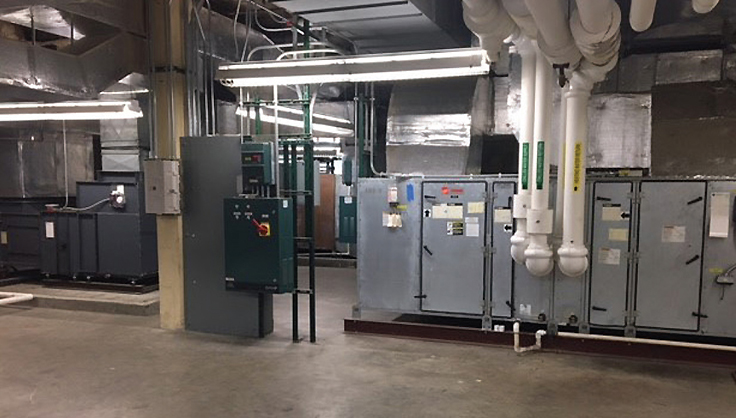 |
GETTING THE JOB DONE Toledo Lucas County Public Library's HVAC room with bipolar ionization system. Photo courtesy of Toledo Lucas County Public Library |
NEEDLEPOINT BIPOLAR IONIZATION
TLCPL and the Public Library of Youngstown & Mahoning County in Ohio both decided to employ needlepoint bipolar ionization. Having received $25,000 per library building from state CARES Act funding, which must be spent by the end of 2020, each system searched for solutions to improve indoor air quality that could be implemented at all locations. While Booth points out that bipolar ionization is used in Europe, there have been no independent laboratory tests done in the United States to prove effectiveness against this virus. “Ionization has been around for a long time, mostly as a way to increase the shelf life of foods,” according to Dave Scanlan, assistant superintendent of facilities and operations at TLCPL. This information led him to Weir, who has a CARES-Act–funded study of the technology underway at Ohio State University for the Department of Corrections.
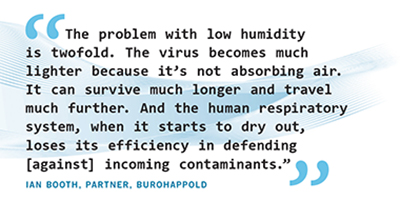 Needlepoint bipolar ionization is a technology for ducted HVAC systems. Weir explains, “An ion is going to oxidize basically anything, because it interacts with surface charge, and then with the actual membrane surface of the virus or the bacteria or the bioaerosol itself. After it gets into the bioaerosol, then it has to actually interact with the virus and inactivate the virus. The science says that an ion will be able to attack and kill a virus. If you have millions and millions of viruses in bioaerosols moving to the HVAC system, and they have survived to the point of reaching the air handler, to be able to be reacted with this ion, you have to have a fairly large enough reaction chamber for those ions to be able to interact with the bioaerosols and the viruses before [the air] gets to the filter, and then the filter does its job.” Since most existing air handlers are smaller than would be needed to destroy SARS-CoV-2 within the air stream, he continues, “I am extremely skeptical about bipolar ionization” to prevent viral transmission.
Needlepoint bipolar ionization is a technology for ducted HVAC systems. Weir explains, “An ion is going to oxidize basically anything, because it interacts with surface charge, and then with the actual membrane surface of the virus or the bacteria or the bioaerosol itself. After it gets into the bioaerosol, then it has to actually interact with the virus and inactivate the virus. The science says that an ion will be able to attack and kill a virus. If you have millions and millions of viruses in bioaerosols moving to the HVAC system, and they have survived to the point of reaching the air handler, to be able to be reacted with this ion, you have to have a fairly large enough reaction chamber for those ions to be able to interact with the bioaerosols and the viruses before [the air] gets to the filter, and then the filter does its job.” Since most existing air handlers are smaller than would be needed to destroy SARS-CoV-2 within the air stream, he continues, “I am extremely skeptical about bipolar ionization” to prevent viral transmission.
The Centers for Disease Control and Prevention (CDC) echoes this skepticism: “Relative to many other air cleaning or disinfection technologies, needlepoint bipolar ionization has a less-documented track record in regard to cleaning/disinfecting large and fast volumes of moving air within HVAC systems. This is not to imply that the technology doesn’t work as advertised, only that in the absence of an established body of evidence reflecting proven efficacy under as-used conditions, the technology is still considered by many to be an ‘emerging technology.’ ”
Weir’s data should be available by late December, but even in advance of that release, one of the main reasons why Toledo and Youngstown libraries chose this technology is that Weir believes “it definitely will change your air quality; it will improve your air quality.”
Aimee Fifarek of the Youngstown Library pointed to the cost effectiveness of this solution. “Everybody had talked about this technology being pretty expensive, but when we priced it out, we realized it was eminently affordable with this pot of money, and so we have proceeded. We are deploying the devices in all of our libraries now.” “Even after [COVID-19] is gone, there are added benefits from an energy saving and/or an air quality perspective,“ says Graybeal. Scanlan adds, “When you start ionizing the air in your building, you cut down on the quantity of outside air required. Less outside air introduced to the building will use less energy to condition the outside air, saving you money.” However, Booth cautions that outdoor air levels should be reduced only if measuring CO2 to ensure that indoor air quality for occupants is satisfactory. With ionization, there is also the possibility that filters will need to be changed more frequently, so both Graybeal and Scanlan have begun to inspect filters more often and track replacement dates.
There is a potential downside to this technology. According to Doyle, older units “produced a significant amount of ozone, a gas that causes oxidation and is toxic to humans. Newer versions have improved and eliminated that risk, but check to make sure any products you are considering are safe. Make sure it’s a zero ozone generator.” The CDC suggests, “If you are considering the acquisition of bipolar ionization equipment...be sure that the equipment meets UL 2998 standard certification (Environmental Claim Validation Procedure [ECVP] for Zero Ozone Emissions from Air Cleaners).” As Booth says, “Only UL listed equipment should be considered, and only in spaces with adequate ventilation and air quality monitoring systems.”
 UVGI
UVGI
Ultraviolet Germicidal Irradiation, or UVGI, uses light in the UV-C spectrum to disinfect water, air, and surfaces. This proven technology has been in use since the mid-20th century, primarily to disinfect wastewater. This part of the light spectrum is harmful to any biological material, including people, so care must be taken in implementation.
Air can be disinfected by irradiating the upper room air only, the full room when it is empty or protective clothing is worn, or air as it passes through HVAC systems, according to the National Institute of Health.
Puniello advises that there are four options for incorporating UVGI into an HVAC system: in the air handling unit, in the air distribution ductwork, in a terminal unit prior to where the air enters the occupied space, or within destratification fans or light fixtures that point upward in the upper part of a high-ceilinged room.
The Edgartown Free Public Library and Chilmark Public Library, both on Martha’s Vineyard, MA, installed UVGI equipment in their air handlers. These two libraries use the same HVAC technician, who recommended the units. UVGI installations must be sized and designed by professionals and installed properly to be effective and safe. There is a significant investment in installation, as well as ongoing maintenance and replacement; lamps must be cleaned regularly to maintain effectiveness, and those currently available must be replaced yearly. An LED version, in development, will cut down on the replacement cost for lamps and labor, but will still require cleaning. UVGI is also available within some HEPA filtration units.
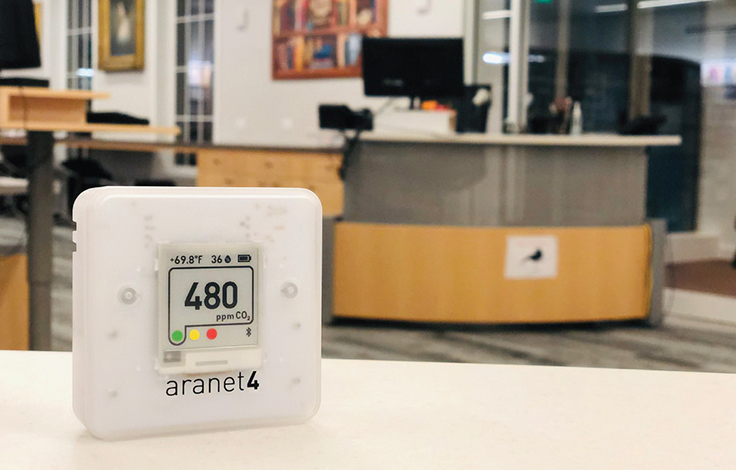 |
CLEAN AIR CARE Edgartown Free Public Library's CO2 monitor, which ensures that indoor air quality is satisfactory. Photo courtesy of Edgartown Free Public Library |
CONCLUSIONS & NEXT STEPS
All of our interviews confirmed that it’s far too soon to make definitive statements about the impact of HVAC systems on the spread of COVID-19. The data about the pandemic and these technologies are evolving rapidly. Please consult ASHRAE, the CDC, and your local engineering and public health departments for the newest information.
We are all still learning, but there are some best practices that will improve indoor air quality and likely decrease virus transmission. None of these are proven, however, and consistently wearing masks and avoiding close contact are recommended, no matter how well your system performs. Bahnfleth reminds us, “No matter what we say about HVAC, that all assumes that the public health guidance that we’ve been getting about masking and distancing and hygiene is in place. It doesn’t substitute for it.”
BEST PRACTICES
- Have your HVAC system assessed by an ASHRAE-certified engineer
- Flush the building two hours before and after occupancy
- Properly install true MERV-13 (not MERV-13-A) or higher filters with no gaps
- If the fans and ducts cannot handle MERV-13, or there is no mechanical ventilation, use portable or fixed HEPA units
- Mechanical (controlled) ventilation is more effective than natural (operable windows)
- Invest in air quality monitoring systems, which can verify the effectiveness of ventilation and filtration systems, resulting in reduced running costs and confirmation of the air quality achieved
These best practices can also be found in the Pandemic section of the authors’ recently released free tool: Library Space: A Planning Resource for Librarians (mblc.state.ma.us/libraryspace). A LibGuide with a frequently updated collection of resources on HVAC and COVID-19 is maintained by the Massachusetts Board of Library Commissioners.
Lauren Stara and Andrea Bunker are Library Building Specialists with the Massachusetts Board of Library Commissioners, helping public libraries around the Commonwealth improve their physical spaces.
RELATED
ALREADY A SUBSCRIBER? LOG IN
We are currently offering this content for free. Sign up now to activate your personal profile, where you can save articles for future viewing









Add Comment :-
Comment Policy:
Comment should not be empty !!!